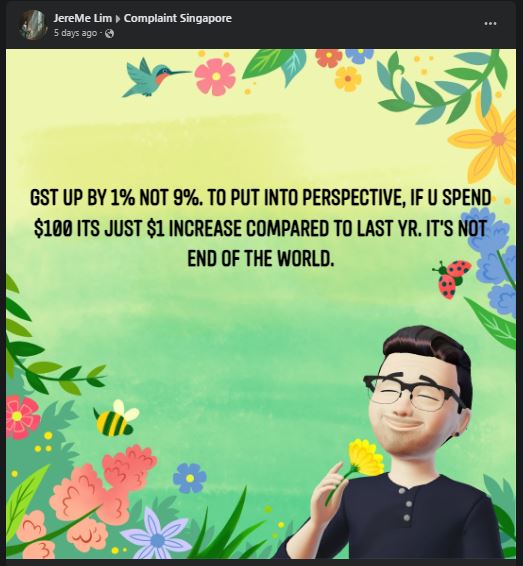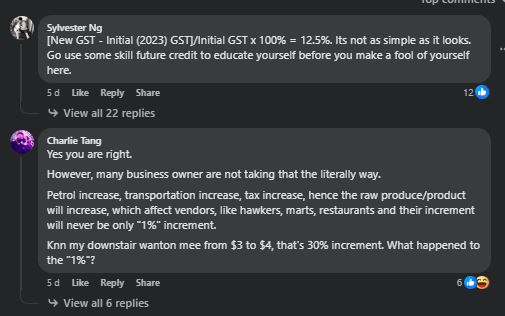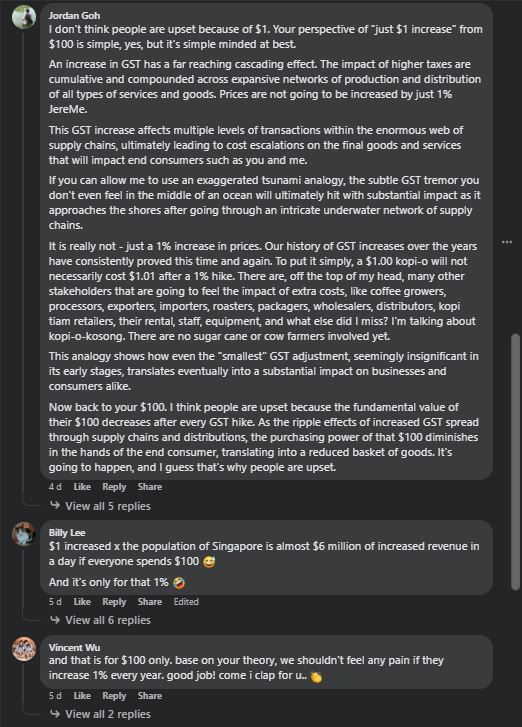In the world of taxation, change is a constant, and the recent adjustment in Singapore’s Goods and Services Tax (GST) from eight to nine per cent has sparked a variety of reactions.
One notable response came from JereMe Lim, an online user who sought to shed light on the perceived severity of the increase.
Perspective on the 1% Increase
JereMe Lim’s take on the matter is pragmatic. In a post on the Complaint Singapore group, he reminded readers that the GST had gone up by 1%, not 9%.
Using a straightforward example, he highlighted that for every $100 spent, the additional cost amounted to just $1 compared to the previous year.
The post, adorned with an avatar of his avatar happily smelling a flower, quickly became a focal point for discussions on the growing financial burden.

Netizens’ response
- Yes you are right.
However, many business owner are not taking that the literally way.
Petrol increase, transportation increase, tax increase, hence the raw produce/product will increase, which affect vendors, like hawkers, marts, restaurants and their increment will never be only “1%” increment.
Knn my downstair wanton mee from $3 to $4, that’s 30% increment. What happened to the “1%”? - [New GST – Initial (2023) GST]/Initial GST x 100% = 12.5%. Its not as simple as it looks. Go use some skill future credit to educate yourself before you make a fool of yourself here.
- I don’t think people are upset because of $1. Your perspective of “just $1 increase” from $100 is simple, yes, but it’s simple minded at best.
An increase in GST has a far reaching cascading effect. The impact of higher taxes are cumulative and compounded across expansive networks of production and distribution of all types of services and goods. Prices are not going to be increased by just 1% JereMe.
This GST increase affects multiple levels of transactions within the enormous web of supply chains, ultimately leading to cost escalations on the final goods and services that will impact end consumers such as you and me.
If you can allow me to use an exaggerated tsunami analogy, the subtle GST tremor you don’t even feel in the middle of an ocean will ultimately hit with substantial impact as it approaches the shores after going through an intricate underwater network of supply chains.
It is really not – just a 1% increase in prices. Our history of GST increases over the years have consistently proved this time and again. To put it simply, a $1.00 kopi-o will not necessarily cost $1.01 after a 1% hike. There are, off the top of my head, many other stakeholders that are going to feel the impact of extra costs, like coffee growers, processors, exporters, importers, roasters, packagers, wholesalers, distributors, kopi tiam retailers, their rental, staff, equipment, and what else did I miss? I’m talking about kopi-o-kosong. There are no sugar cane or cow farmers involved yet.
This analogy shows how even the “smallest” GST adjustment, seemingly insignificant in its early stages, translates eventually into a substantial impact on businesses and consumers alike.
Now back to your $100. I think people are upset because the fundamental value of their $100 decreases after every GST hike. As the ripple effects of increased GST spread through supply chains and distributions, the purchasing power of that $100 diminishes in the hands of the end consumer, translating into a reduced basket of goods. It’s going to happen, and I guess that’s why people are upset. - $1 increased x the population of Singapore is almost $6 million of increased revenue in a day if everyone spends $100
And it’s only for that 1%


